Evaluating Samsung's QHD AMOLED Displays
by Joshua Ho on July 16, 2014 6:00 AM EST- Posted in
- Smartphones
- Samsung
- Mobile
- Laptops
- Snapdragon 805
- Galaxy S5
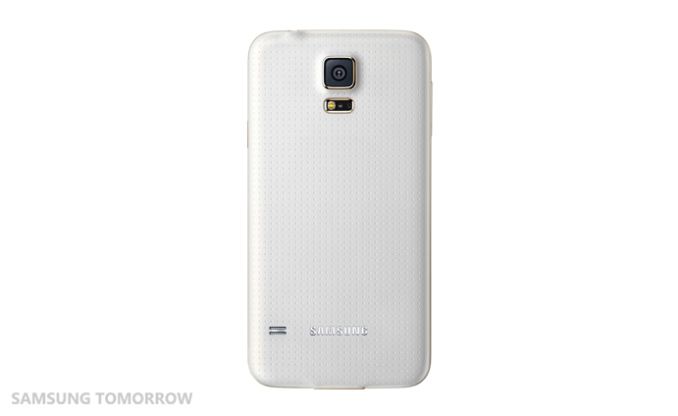
Recently, a package showed up at my door. While this is normally not worth talking about, the Galaxy S5 Broadband LTE-A happened to be in the box. For those unfamiliar with this phone, it's basically a refresh of the Galaxy S5. This means a Snadragon 805 SoC instead of Snapdragon 801. This also means a minor new revision of Krait (450 vs 400), a new GPU, and a separate MDM9x35 modem on a new process (20nm SoC vs 28nm HPm). This variant also ships with more RAM (3GB vs 2GB) and more internal storage (32GB vs 16GB). The display is also higher resolution (2560x1440 vs 1920x1080).
In terms of the resolution itself, the GS5 Broadband LTE-A doesn't seem to hold a significant advantage over the original Galaxy S5. While it's still possible to see the difference, once again I don't find it to be significant. It may be of value to others, but I think the PPI race needs to stop here, as I find it hard to justify the relatively minor resolution increase over the potential battery life gains and opportunity cost of pursuing higher pixel density over other display characteristics. Going to 4K would make even less sense at this display size, although there may be value to 4K in a tablet display. In the case of this display, I only see around a 10 nit reduction in brightness as the maximum luminance in auto brightness is around 430 nits, while on the older Galaxy S5 it was 440 nits. When set manually, the display has a peak luminance of 368 nits, a minor improvement over the previous model.
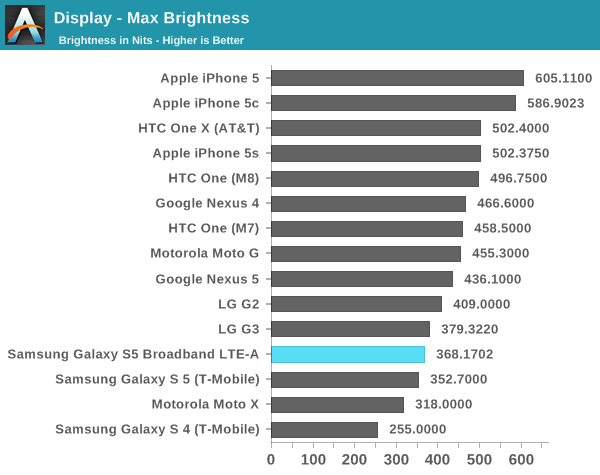
Of course, resolution isn't everything. Testing color accuracy is also important, which is the real surprise here. As always, these tests are run using an i1Pro for all measurements but contrast, and done using a custom workflow in SpectraCal's CalMAN 5. All color/grayscale measurements have been done in cinema mode as it is closest to targeting sRGB.
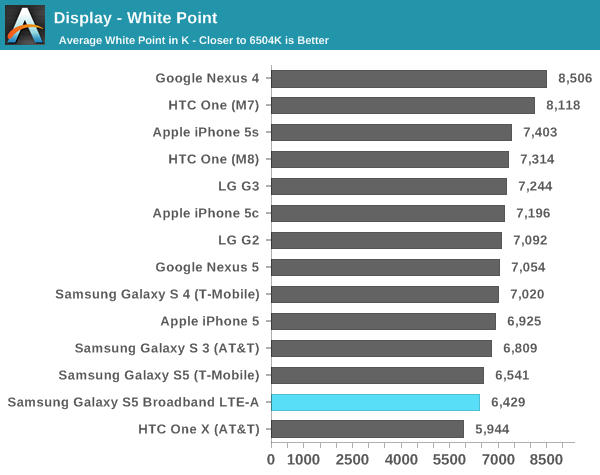

Based on grayscale alone, Samsung sets a new record for color accuracy in this department. It's definitely a healthy leap forward from the original Galaxy S5. In subjective viewing there are still some minor issues with excessive green in the color balance, but it's much better than before. The contrast is still just as dark as before. In a completely dark room, I can't tell whether the screen has turned off when displaying an all-black image.
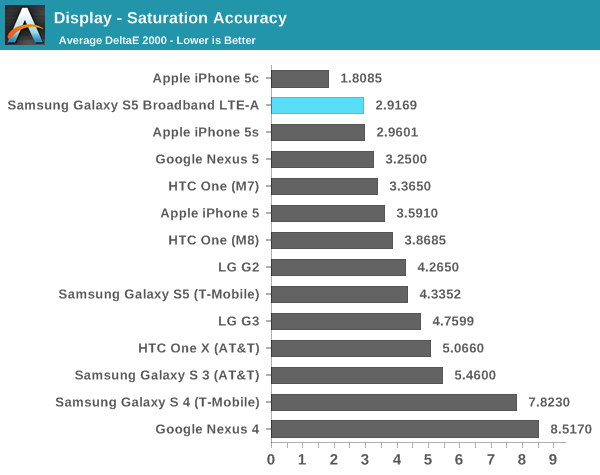
In saturations, Samsung has done an incredible job of calibrating the display. Just looking at the graph of dE2000 averages, there is clear improvement from generation to generation. Samsung is now tied with Apple for color accuracy in this department.
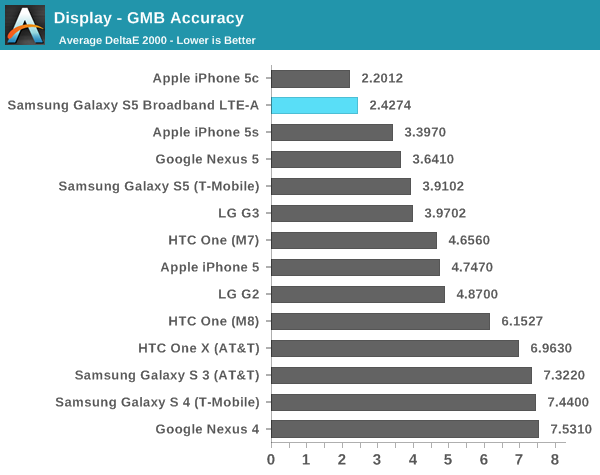
While the saturation test is important, it's often not as rigorous at the GMB ColorChecker test. It's fully possible for a display to do well in the saturation test but fall flat in this one. Fortunately, this isn't the case here. Samsung has managed to approach the iPhone 5c in calibration accuracy here, easily setting a record amongst Android OEMs. The difference in color is definitely noticeable when compared to a Galaxy S5, and I hope that every Android OEM follows Samsung's lead in this department.
Based upon this initial evaluation of Samsung's first quad HD AMOLED display, things are looking good. There is a small drop in the maximum luminance but nothing significant. The next critical piece of the puzzle is whether power draw is significantly worse on the Galaxy S5 Broadband LTE-A, although those results and the full review aren't quite ready yet. While only one aspect, things are currently looking up for the GS5 Broadband LTE-A, even if the name is a bit long. This may also represent a change in the future of mobile displays, as AMOLED increasingly seems poised to supplant LCD technologies. Unfortunately, as Samsung seems to be the sole supplier of such displays other OEMs are unlikely to adopt AMOLED until other vendors catch up with equivalent technology.


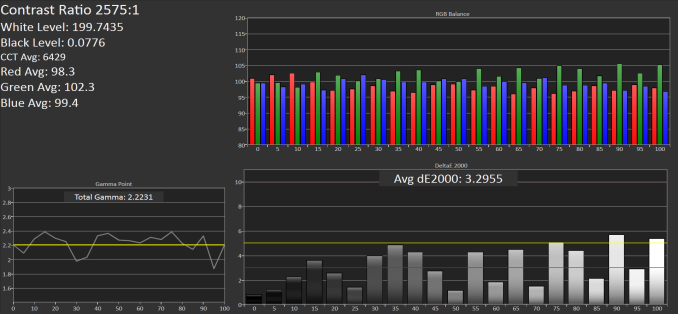

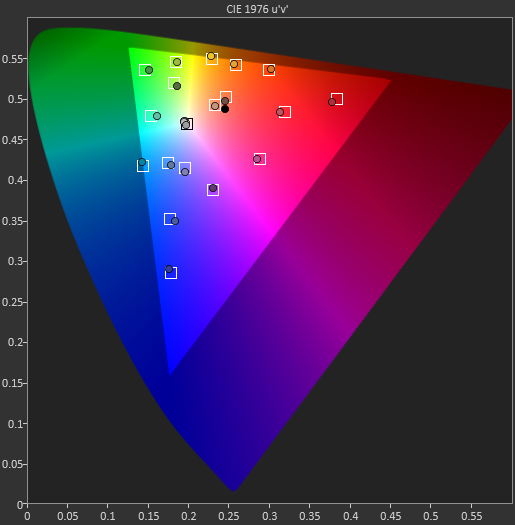








71 Comments
View All Comments
akdj - Friday, July 18, 2014 - link
I should mention EVERY Browser I use in iOS as well as Android use reflow. I'm not familiar with Windows phones, but each browser bakes it into their code. Safari has had it since day one. I prefer iCab and Mercury or Chrome...but all four use reflow in their iOS browsers. Same as Android (I own both the 5s and Note3)sonicmerlin - Sunday, July 20, 2014 - link
*facepalm* You obviously don't know what text reflow (aka text wrap) is. I'm using an iPad right now and none of the browsers have it. When you zoom in on a web page until the sentences flow past your screen border you can't automatically reformat the line width of the text so that it fits within your phone's view window. In fact Chrome on Android doesn't implement this feature either.Some iOS browsers let you increase font size but more often than not this destroys the website's formatting and lines start to overlap. Text reflow is a far more elegant solution.
dwade123 - Wednesday, July 16, 2014 - link
Too bad they can't test burn-ins, because OLED is full of them.janderk - Thursday, July 17, 2014 - link
OLED technology has evolved a lot. The last time I saw burn-ins on a OLED screen was on my Google Nexus One. And then only just slightly after a year of intensive use.zodiacfml - Thursday, July 17, 2014 - link
Hmm, I got a feeling this S5 would leave the LG G3 in the dust. I think OLED is better fit for high resolution displays since it probably won't reduce power efficiency, only lower maximum brightness.zodiacfml - Thursday, July 17, 2014 - link
I have to correct it, not maximum brightness of the whole screen but local/pixel brightness. I also don't see anything bad with higher resolution displays as long it doesn't affect too much image quality, performance, power efficiency and price. The PPI of the Nexus 5 is well enough for me, it just needs AMOLED type of image quality since the "blacks" are pretty washed out.akdj - Friday, July 18, 2014 - link
Helps it has the quicker SoC, GPU and more RAM as well, I would assume. I was kinda shocked the G3 went with the 801/320 combo myself. The S5 going to the 805/420 was a smart move by Samsung, of course TouchWiz can use a few extra resources than 'other' OEM's UIemn13 - Sunday, July 20, 2014 - link
Isn't it weird to look at saturation accuracy over hue accuracy? We're much more sensitive to hue inaccuracies and *relative* saturation inaccuracies, but not really to *absolute* saturation inaccuracies.In fact, because newer displays have the capability to show greater saturations, I can well imagine I'd prefer an inaccurate (but accurate in relative sense) screen that was oversaturated.
It certainly looks like saturated screens are possibly preferred by some if you look at the TV market.
Given the small gamut that sRGB actually covers, I'd prefer an analysis that emphasizes hue and relative saturation accuracy, and not absolute accuracy (as in, it's nice to know how saturated a screen is, but not to conflate that with accuracy in areas where it matters).
Although true perceptual quality does correlate with accuracy, it's far from a perfect correlation. More useful measurements (such as hue and grayscale accuracy) would make it easier to get a good picture of how good a screen actually is.
AbRASiON - Saturday, August 2, 2014 - link
I completely agree regarding the race for unnecessary pixels in a phone display, but I will say that we actually do need a 4k display in 5.1" or 5.5" for devices like the Oculus rift.This 2560x1440 display means only 1280x1440 resolution per eye, were it to go inside the Oculus version 3. With some really good AA, that's not bad but it's still not great.
Sb87 - Tuesday, August 5, 2014 - link
Can you please add black level tests to the Mobile 14 Bench for both GS5 and this new display? Thanks!